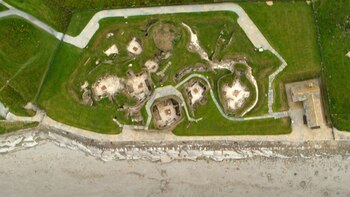The Ness of Brodgar, the archaeological jewel for more than 5,000 years ago that connects past and mystery


In the heart of the Orcadas Islandsan archipelago to the northeast of Scotland, lies an archaeological site that has transformed our understanding of the Stone age As reported Smithsonian Magazinehe Ness of Brodgardiscovered by accident in 2003, has revealed A monumental complex of Neolithic structures dating back more than 5,000 years. This finding, which began with a simple stone trapped in the plow of a tractor, has become one of the most important and extensive excavations of Great Britain, offering a unique window to the remote past of humanity.
The initial discovery occurred when Carole Hoeyresident of the area, noticed that a tractor working in a nearby field suddenly stopped. As they approached, the farmers found a rectangular slab of more than 1.5 meters long, with marks that suggested that it had been deliberately worked. What was initially thought that it was a tomb of the Bronze age It turned out to be something much older and complex: the remains of a Neolithic building. Since then, the site has revealed a monumental settlement that was in use for approximately 1,200 years, from 3,500 BC to 2,400 AC
According to Smithsonian Magazinehe Ness of Brodgar covers an area of 2.8 hectares and contains at least 40 structures Identified, although geophysical studies suggest that there could be up to 200. These buildings, built with stone extracted from local quarries, stand out for their size and sophistication. One of the most impressive, known as Structure 27measures approximately 17 meters long by 11 meters wide, and its masonry is so precise that it seems newly built.
The director of the excavation, Nick CardHe pointed out that the quality of work suggests the existence of construction specialists, such as Canteros and Architects, at a time when humanity was just beginning to settle agriculture. However, the exact purpose of these structures remains a mystery. Although initially it was thought that they could have been temples or neolithic cathedrals, archaeologists now believe that some may have been elite residences or meeting places for large crowds.

The medium Ancient Origins He stressed that the Ness of Brodgar It could have been a meeting center for communities throughout the region, and even beyond. Evidence as tools and materials from places as far away as the island of Arran, on the west coast of Scotland, suggest that there were networks of trade and cultural contact. In addition, the remains of a massive banquet, in which at least 400 cows were sacrificed around 2,400 BC, indicate that the site was the scene of large -scale events. The bones of these animals were carefully arranged around the Structure 10possibly as a symbol of abundance and power.
The symbolism of animals, especially cattle, seems to have been fundamental for the inhabitants of Orkney. As explained by the archaeologist Mark Edmonds a Smithsonian Magazine, Cows were a reflection of human communities, with both material and metaphorical value.
One of the most fascinating aspects of Ness of Brodgar It is the amount of rock art discovered on the site. According to Smithsonian Magazinemore than 1,200 examples of engravings have been found, surpassing any other place in Britain. Among the designs are crosses, triangles, zigzags and brands known as “cup-market”. However, the meaning of these decorations remains uncertain.
Two particular findings have captured the imagination of archaeologists and visitors: the Ax of heaven and the Butterfly stone. The first, discovered in 2012 by the Archeology student Jessica Heupelit is a polished stone ax head with a pattern that seems to reflect the sky. The second, found by the archaeologist Jo BourneIt is a slab decorated with a reason that resembles a butterfly. Both objects, carefully deposited in ritual contexts, suggest that the inhabitants of the NESS attributed a special meaning to certain objects and materials.






